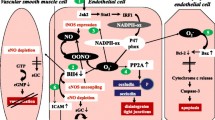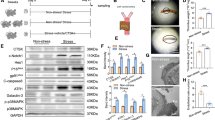Abstract
Protective effects of ischemic postconditioning in myocardial ischemia/reperfusion (I/R) injury have been ever demonstrated, but the exact mechanisms remain unclear. Because of their multiplex activities, using natural pharmaceuticals seems to be clinically interesting. The aim of present study was to investigate the effects of troxerutin preconditioning and ischemic postconditioning on inflammatory responses after myocardial I/R injury in a rat model. Twenty-four Wistar rats were divided into four groups as the control, troxerutin receiving (TXR), postconditioning receiving (PostC), and combined therapy (TXR + PostC). Rats’ isolated hearts underwent 30-min LAD regional ischemia followed by 45-min reperfusion. Troxerutin was orally administered for a month before I/R. Ischemic PostC was applied by alternative three cycles of 30-s R/I at the onset of reperfusion. The coronary effluent and ischemic left ventricular samples were used to determine the activities of creatine kinase (CK), intercellular adhesion molecule-1 (ICAM-1), interlukin-1beta (IL-1β), tumor-necrosis factor (TNF-α), and also histopathological studies. Pretreatment of rats with troxerutin significantly reduced myocardial inflammatory cytokines TNF-α and IL-1β levels and ICAM-1 activity after I/R insult compared to those of control I/R hearts (P < 0.05). Application of PostC showed similar impacts on those parameters. In fact, anti-inflammatory mechanisms of both treatments were associated with their protective effects against myocardial damages causing from I/R injury. Pretreatment with troxerutin as well as postconditioning can induce cardioprotection through prevention of the cell-cell interaction and release of inflammatory mediators, minimizing I/R pathological changes in myocardial cells. These two treatments may share same mechanisms in their actions since they showed no significant additive effects.





Similar content being viewed by others
References
Hoffman, J.W., T.B. Gilbert, R.S. Poston, and E.P. Silldorff. 2004. Myocardial reperfusion injury: etiology, mechanisms, and therapies. The Journal of Extra-Corporeal Technology 36(4): 391–411.
Balakumar, P., A. Rohilla, and M. Singh. 2008. Pre-conditioning and postconditioning to limit ischemia–reperfusion-induced myocardial injury: what could be the next footstep? Pharmacological Research 57(6): 403–412.
Marzilli, M., and A. Huqi. 2010. Cardioprotective therapy in reperfusion injury: lessons from the European Myocardial Infarction Project-Free Radicals (EMIP-FR). Heart and Metabolism 46(1): 35–37.
Perrelli, M.G., P. Pagliaro, and C. Penna. 2011. Ischemia/reperfusion injury and cardioprotective mechanisms: role of mitochondria and reactive oxygen species. World Journal of Cardiology 3(6): 186–200.
Yellon, D.M., and D.J. Hausenloy. 2007. Myocardial reperfusion injury. New England Journal of Medicine 357(1): 1121–1135.
Badalzadeh, R., B. Mokhtari, and R. Yavari. 2015. Contribution of apoptosis in myocardial reperfusion injury and loss of cardioprotection in diabetes mellitus. Journal of Physiological Sciences 65(3): 201–215.
Nikolaos, G., C. Frangogiannis, W. Smith, and M.L. Entman. 2002. The inflammatory response in myocardial infarction. Cardiovascular Research 53(1): 31–47.
Ebrahimi, H., R. Badalzadeh, M. Mohammadi, and B. Yousefi. 2014. Diosgenin attenuates inflammatory response induced by myocardial reperfusion injury: role of mitochondrial ATP-sensitive potassium channels. Journal of Physiology and Biochemistry 64: 393–400.
Jordan, J.E., Z.Q. Zhao, and J.V. Johansen. 1999. The role of neutrophils in myocardial ischemia–reperfusion injury. Cardiovascular Research 43(4): 860–878.
Jiang, W.L., F.H. Fu, B.M. Xu, J.W. Tian, H.B. Zhu, and J. Hou. 2010. Cardioprotection with forsythoside B in rat myocardial ischemia-reperfusion injury: Relation to inflammation response. Phytomedicine 17: 635–639.
Ren, J.Y., J.X. Song, M.Y. Lu, and H. Chen. 2011. Cardioprotection by ischemic postconditioning is lost in isolated perfused heart from diabetic rats: Involvement of transient receptor potential vanilloid 1, calcitonin gene-related peptide and substance P. Regulatory Peptides 169(1): 49–57.
Ferdinandy, P., D.J. Hausenloy, G. Heusch, G.F. Baxter, and R. Schulz. 2014. Interaction of risk factors, comorbidities, and comedications with ischemia/reperfusion injury and cardioprotection by preconditioning, postconditioning, and remote conditioning. Pharmacological Reviews 66(4): 1142–1174.
Badalzadeh, R., M. Mohammadi, M. Najafi, N. Ahmadiasl, S. Frajnia, and H. Ebrahimi. 2011. The additive effects of ischemic postconditioning and cyclosporine-A on nitric oxide activity and functions of diabetic myocardium injured by ischemia/reperfusion. Journal of Cardiovascular Pharmacology and Therapeutics 17(2): 181–189.
Zhao, Z.Q., and J.V. Johansen. 2006. Postconditioning: Reduction of reperfusion-induced injury. Cardiovascular Research 70(2): 200–211.
Siegers, C.P., S.S. Ali, and M. Tegtmeier. 2008. Aescin and troxerutin as a successful combination for the treatment of inner ear perfusion disturbances. Phytomedicine 15(3): 160–163.
Vinothkumara, R., R. Vinoth Kumar, V. Karthikkumar, P. Viswanathan, J. Kabalimoorthy, and N. Nalini. 2014. Oral supplementation with troxerutin (trihydroxyethylrutin), modulates lipid peroxidation and antioxidant status in 1,2-dimethylhydrazine-induced rat colon carcinogenesis. Environmental Toxicology and Pharmacology 37: 174–184.
Liu, C.M., J.Q. Ma, and Y. Lou. 2010. Chronic administration of troxerutin protects mouse kidney against D-galactose-induced oxidative DNA damage. Food and Chemical Toxicology 48(10): 2809–2817.
Zhang, Z.F., S.H. Fan, Y.L. Zheng, J. Lu, D.M. Wu, Q. Shan, and B. Hu. 2014. Troxerutin improves hepatic lipid homeostasis by restoring NAD+-depletion-mediated dysfunction of lipin 1 signaling in high-fat diet-treated mice. Biochemical Pharmacology 91(1): 74–86.
Lu, J., D. Wu, B. Hu, W. Cheng, Y. Zheng, Z.F. Zhang, Q. Ye, S.H. Fan, Q. Shan, and Y.J. Wang. 2010. Chronic administration of troxerutin protects mouse brain against D-galactose-induced impairment of cholinergic system. Neurobiology of Learning and Memory 93(2): 157–164.
Lu, J., D.M. Wu, Z.H. Zheng, Y.L. Zheng, B. Hu, and Z.F. Zhang. 2011. Troxerutin protects against high cholesterol-induced cognitive deficits in mice. Brain 134: 783–797.
Badalzadeh, R., N. Layeghzadeh, A. Alihemmati, and M. Mohammadi. 2015. Beneficial effect of troxerutin on diabetes-induced vascular damages in rat aorta: histopathological alterations and antioxidation mechanism. International Journal of Endocrinology and Metabolism 13(2): e25969.
Mokhtari, B., R. Badalzadeh, A. Alihemmati, and M. Mohammadi. 2015. Phosphorylation of GSK-3β and reduction of apoptosis as targets of troxerutin effect on reperfusion injury of diabetic myocardium. European Journal of Pharmacology 765: 316–321.
Badalzadeh, R., B. Yousefi, A. Tajaddini, and N. Ahmadian. 2014. Diosgenin-induced protection against myocardial ischaemia-reperfusion injury is mediated by mitochondrial K-ATP channels in a rat model. Perfusion 30(7): 565–571.
Ghyasi, R., G. Sepehri, M. Mohammadi, R. Badalzadeh, and B. Rashidi. 2011. The effect of mebudipine on cardiac function and activity of the myocardial nitric oxide system in ischaemia–reperfusion injury in rats. Cardiovascular Journal of Africa 22(6): 319–323.
Bradford, M.M. 1976. A rapid and sensitive method for the quantitation of microgram quantities of protein utilizing the principle of protein-dye binding. Analytical Biochemistry 72: 248–254.
Mahmut, A., E.B. Mehmet, A. Hulya, E. Fazli, and K.E. Mustafa. 2003. Protective effects of melatonin against myocardial injury induced by isoproterenol in rats. Journal of Pineal Research 35: 75–79.
Saini, H.K., Y.-J. Xu, M. Zhang, P.P. Liu, L.A. Kirshenbaum, and N.S. Dhalla. 2005. Role of tumour necrosis factor-alpha and other cytokines in ischemia-reperfusion-induced injury in the heart. Experimental and Clinical Cardiology 10(4): 213–222.
Burne, M.J., A. Elghandour, M. Haq, S.R. Saba, J. Norman, T. Condon, F. Bennett, and H. Rabb. 2001. IL-1 and TNF independent pathways mediate ICAM-1/VCAM-1 up-regulation in ischemia reperfusion injury. Journal of Leukocyte Biology 70(2): 192–198.
Badalzadeh, R., M. Mohammadi, B. Yousefi, S. Farajnia, M. Najafi, and S. Mohammadi. 2015. Involvement of glycogen synthase kinase-3β and oxidation status in the loss of cardioprotection by postconditioning in chronic diabetic male rats. Advanced Pharmaceutical Bulletin 5(3): 321–327.
Badalzadeh, R., R. Yavari, and D. Chalabiani. 2015. Mitochondrial ATP-sensitive K+ channels mediate the antioxidative influence of diosgenin on myocardial reperfusion injury in rat hearts. General Physiology and Biophysics 34(3): 323–329.
Jun, L., W. Dong-Mei, Z. Yuan-Lin, H. Bin, C. Wei, Z. Zi-Feng, and L. ad Meng-qiu. 2013. Troxerutin counteracts domoic acid- induced memory deficits in mice by inhibiting CCAAT/enhancer binding protein b-mediated inflammatory response and oxidative stress. The Journal of Immunology 190: 3466–3479.
Zhang, Z.F., Y.Q. Zhang, S.H. Fan, J. Zhuang, Y.L. Zheng, J. Lu, D.M. Wu, Q. Shan, and B. Hu. 2015. Troxerutin protects against 2,2′,4,4′-tetrabromodiphenyl ether (BDE-47)-induced liver inflammation by attenuating oxidative stress-mediated NAD+-depletion. Journal of Hazardous Materials 283: 98–109.
Acknowledgments
This study was supported through a grant from Immunology Research Center and Drug Applied Research Center, Tabriz University of Medical Sciences, Iran.
Author information
Authors and Affiliations
Corresponding author
Ethics declarations
Conflict of Interest
The authors declare that they have no competing interests.
Rights and permissions
About this article
Cite this article
Badalzadeh, R., Baradaran, B., Alihemmati, A. et al. Troxerutin Preconditioning and Ischemic Postconditioning Modulate Inflammatory Response after Myocardial Ischemia/Reperfusion Injury in Rat Model. Inflammation 40, 136–143 (2017). https://doi.org/10.1007/s10753-016-0462-8
Published:
Issue Date:
DOI: https://doi.org/10.1007/s10753-016-0462-8




